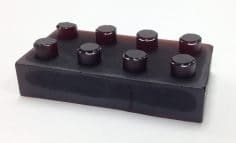A team of chemists set out to make plastic from rubbish and ended up with a soft rubbery product that can soak up mercury like a sponge, making contaminated water safe again:

It also changes colour, from dark red to bright yellow, when it comes into contact with mercury, meaning it could be a useful indicator in water testing. See this on the following time-lapse video;
(video via Flinders University, credit: Max Worthington)
Listen to a full report from ABC News (Australia).
Mercury is extremely toxic, particularly to children, and is found in contaminated water worldwide. Even very low levels can lead to health problems because a) mercury becomes concentrated up the food chain and so humans most often ingest it by eating contaminated fish or shellfish, and b) it stays in the body for a long time; it takes around 70 days to eliminate completely.
The new product is made from a chemical reaction of sulphur – a waste product from the oil industry – with limonene, which is easily extracted from citrus peel.
As well as securing clean water supplies in areas where mercury contamination has occurred, this material might be adapted to remove mercury from the solid waste at water treatment plants, according to John Miller from The Remediation Group. This waste would then be safe to burn as fuel or spread on the land as a fertiliser.
It seems unlikely that this could deal with the widespread low-level mercury contamination all over the world, thanks to coal mining and burning, among other industrial activities. But for niche applications, at least, it looks like a case of serendipity for these innovative scientists.
Featured image via Wikimedia Commons


















